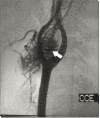Carotid body tumor: retrospective analysis on 22 patients
- PMID: 24760216
- PMCID: PMC10852084
- DOI: 10.1590/1516-3180.2014.1323452
Carotid body tumor: retrospective analysis on 22 patients
Abstract
Context and objective: Carotid body tumors, or chemodectomas, are the most common head and neck paragangliomas, accounting for 80% of the cases. They may present minor symptoms; however, they deserve special attention in order to achieve accurate diagnosis and adequate treatment. The objectives of this study were to show the approach towards chemodectomas and evaluate the complications of the patients treated surgically without previous embolization.
Design and setting: Retrospective study on chemodectomas followed up at the Head and Neck Surgery Service, Department of Surgery, Unicamp.
Methods: Twenty-two patients were evaluated between 1983 and 2009. The diagnosis was based on clinical findings and imaging methods. The epidemiological characteristics, lesion characteristics, diagnostic methods, treatment and complications were analyzed.
Results: The paragangliomas were classified as Shamblin I (9%), II (68.1%) and III (22.7%). Angiography, magnetic resonance imaging and computed tomography confirmed the diagnosis in 20 patients (90.9%). Five (22.7%) had significant bleeding during the surgery, while four (18.1%) had minor bleeding. Four patients (18.1%) developed neurological sequelae. Seven (31.8%) needed ligatures of the external carotid artery. Three patients (13.6%) underwent carotid bulb resection. The postoperative follow-up ranged from 3 months to 14 years without recurrences or mortality.
Conclusions: In our experience and in accordance with the literature, significant bleeding and neurological sequelae may occur in chemodectoma cases, particularly in Shamblin III patients. The complications from treatment without previous embolization were similar to data in the literature data, from cases in which this procedure was applied prior to surgery.
CONTEXTO E OBJETIVO:: O tumor de corpo carotídeo, ou quimiodectoma, é o paraganglioma mais comum em cabeça e pescoço, com aproximadamente 80% dos casos. Pode apresentar poucos sintomas; no entanto, necessita atenção especial para o diagnóstico e tratamento adequado. Os objetivos deste estudo são mostrar a abordagem do quimiodectoma e avaliar as complicações nos pacientes tratados cirurgicamente sem embolização prévia.
TIPO DE ESTUDO E LOCAL:: Estudo retrospectivo de quimiodectomas acompanhados pelo Serviço de Cirurgia de Cabeça e Pescoço, Departamento de Cirurgia, Unicamp.
MÉTODOS:: Vinte e dois pacientes foram avaliados entre 1983 e 2009. O diagnóstico foi baseado em achados clínicos e métodos de imagens. Foram analisados aspectos epidemiológicos, características das lesões, métodos diagnósticos, tratamento e complicações.
RESULTADOS:: Os paragangliomas foram classificados em Shamblin I (9%), II (68,1%) e III (22,7%). Angiografia, ressonância nuclear magnética e tomografia computadorizada confirmaram o diagnóstico em 20 pacientes (90,9%). Cinco (22,7%) tiveram sangramento significativo durante a cirurgia, enquanto quatro (18,1%) tiveram sangramento mínimo. Quatro pacientes (18,1%) tiveram sequelas neurológicas. Sete (31,8%) necessitaram de ligadura da artéria carótida externa. Três (13,6%) foram submetidos a ressecção do bulbo carotídeo. O acompanhamento variou de 3 meses a 14 anos, sem recorrências ou óbitos.
CONCLUSÕES:: Em nossa experiência e de acordo com a literatura, sangramentos significativos e sequelas neurológicas podem ocorrer nos quimiodectomas principalmente em pacientes Shamblin III. As complicações do tratamento sem embolização prévia foram similares aos relatos observados na literatura nos quais se aplicou tal procedimento antes da cirurgia.
Conflict of interest statement
Figures






Similar articles
-
[Paraganglioma of the neck. Analysis of 32 operated cases].Minerva Chir. 1991 Oct 31;46(20):1109-17. Minerva Chir. 1991. PMID: 1766558 Italian.
-
Carotid body tumors, inheritance, and a high incidence of associated cervical paragangliomas.Am J Surg. 1996 Aug;172(2):196-9. doi: 10.1016/S0002-9610(96)00151-1. Am J Surg. 1996. PMID: 8795531
-
Surgical treatment of paragangliomas of the neck.Int Surg. 1997 Oct-Dec;82(4):394-7. Int Surg. 1997. PMID: 9412839
-
[Carotid body tumors: report of ten cases].Rev Med Chil. 2007 Nov;135(11):1414-20. Epub 2008 Jan 16. Rev Med Chil. 2007. PMID: 18259652 Review. Spanish.
-
Imaging and management of head and neck paragangliomas.Eur Radiol. 2005 Jul;15(7):1310-8. doi: 10.1007/s00330-005-2743-8. Epub 2005 Apr 5. Eur Radiol. 2005. PMID: 15809825 Review.
Cited by
-
Case report: Cardiac arrest during carotid body tumor resection indicating carotid sinus hypersensitivity.Front Cardiovasc Med. 2022 Dec 16;9:996644. doi: 10.3389/fcvm.2022.996644. eCollection 2022. Front Cardiovasc Med. 2022. PMID: 36588565 Free PMC article.
-
BILATERAL CAROTID BODY PARAGANGLIOMAS - LITERATURE REVIEW AND COMMENTS IN A PATIENT WITH NO SIGNS OF MEN SYNDROME.Acta Endocrinol (Buchar). 2023 Jan-Mar;19(1):133-141. doi: 10.4183/aeb.2023.133. Epub 2023 Aug 14. Acta Endocrinol (Buchar). 2023. PMID: 37601710 Free PMC article.
-
Diagnosis and treatment of carotid body tumors.Am J Transl Res. 2021 Dec 15;13(12):14121-14132. eCollection 2021. Am J Transl Res. 2021. PMID: 35035757 Free PMC article.
-
Diagnosis and treatment of a carotid body tumor: A case report of a rare bilateral tumor.Oncol Lett. 2017 Dec;14(6):6417-6420. doi: 10.3892/ol.2017.7101. Epub 2017 Sep 28. Oncol Lett. 2017. PMID: 29375704 Free PMC article.
-
Challenging carotid body tumor resection.Proc (Bayl Univ Med Cent). 2025 Jan 24;38(3):350-353. doi: 10.1080/08998280.2024.2448622. eCollection 2025. Proc (Bayl Univ Med Cent). 2025. PMID: 40291106 Free PMC article.
References
-
- Nora JD, Hallett JW Jr, O'Brien PC, et al. Surgical resection of carotid body tumors: long-term survival, recurrence, and metastasis. Mayo Clin Proc. 1988;63(4):348–352. - PubMed
-
- Sanghvi VD, Chandawarkar RY. Carotid body tumors. J Surg Oncol. 1993;54(3):190–192. - PubMed
-
- Brown JS. Glomus jugulare tumors revisited: a ten-year statistical follow-up of 231 cases. Laryngoscope. 1985;95(3):284–288. - PubMed
MeSH terms
LinkOut - more resources
Full Text Sources
Other Literature Sources
Medical

